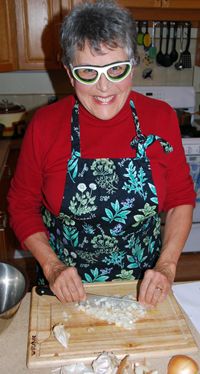
RECIPES
Black Bean Stew with Orange and Chipotles
Orange Salsa
Golden Beet and Orange Salad with Yogurt Dressing
Chicken with Orange Sauce
Orange Sauce
Duck a l’Orange
The first three recipes are simple and easy. The chicken and duck are not difficult, but require a few more steps. The good thing is they can be done ahead of time, if you are having guests, and reheated in the orange sauce just before dinnertime. The orange sauce is good for both the chicken and the duck, so is included as its own recipe. It would also be an excellent sauce for venison or moose.
Nutritional data on oranges:
http://www.healthalternatives2000.com/fruit-nutrition-chart.html
http://www.nutritiondata.com/facts/fruits-and-fruit-juices/1966/2
Black Bean Stew with Orange and Chipotles
This recipe is adapted from Hollyhock Cooks, by Linda Solomon and Morek Jolar. Gabriola Island, BC:
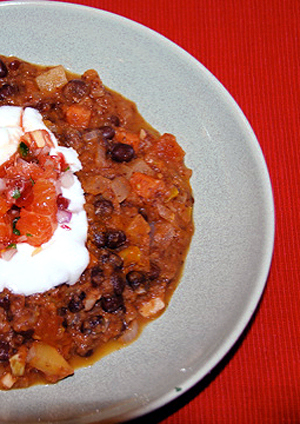
New Society Publishers, 2003. You can use almost any root vegetable except red beets to accompany the black beans. I like the veg tender-crisp, but if you prefer them well-cooked, simmer the chopped veg before adding them to the stew. This is good on its own, but really yummy with the yogurt and the orange salsa.
2 tbls olive oil
1 large onion, finely chopped
1 large clove garlic, minced
4 large carrots, diced and cooked in water for 5 minutes
half a small turnip or rutabaga, diced and cooked in water for 5 minutes. (Optional)
1 cup orange juice.
1 tsp salt
1 tsp ground cumin
1 tsp chipotle pepper in adobo sauce, chopped. (Add more if you like it hotter, but do it one tsp at a time.)
4 cups cooked black beans, drained and rinsed. To use dried beans, soak 1 cup beans overnight then boil until done with 1 tsp salt. If using canned beans, drain and rinse well.
1 large tin chopped tomatoes
Saute the onion and garlic in the olive oil. When translucent, add the beans, cooked carrot and turnip, orange juice, salt, cumin, and chipotle. Add the tomatoes.
Simmer for 30 minutes. Ladle about 3 cups into a blender and puree. Return the puree to the stew pot and mix with the beans. Simmer another 15 minutes.
Variation: You could use celery, potato, squash, corn, peas, or sweet bell pepper, in place of, or as well as, the carrot and turnip. If using corn, put it in after pureeing some of the stew.
Serve with a dollop of plain yogurt and orange salsa.
Orange Salsa
1 white onion, chopped
1 shallot, finely minced
3 oranges, peel and seeds removed, and chopped,
3 tbsp finely minced poblano pepper (the long dark green one—it’s slightly hot. If you want more heat, use a jalapeno seeded and minced. For fiery hot, use the whole jalapeno pepper, seeds and all.)
juice of one lemon
juice of one lime
1 tsp. sugar
cilantro and salt to taste.
Chop and mix all together in a bowl. Don’t make this in a food processor—it turns to mulch, whereas it needs to be a little chunky, with the orange and onion discernible as separate items.
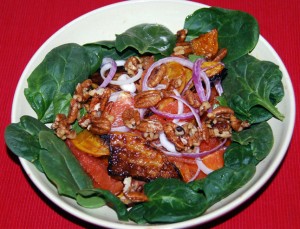
Golden Beet and Orange Salad with Orange Yogurt Dressing
This is a beautiful and zingy salad. Roasting the golden beetroot first makes it very succulent and rich, and paired with the tart orange sections, it’s hard to actually get it into the salad, as you will be tempted as I was to eat the separate components on their own while you make it. The honeyed nuts are optional.
2 large golden beets
2 large naval oranges. The pink ones hold their shape well and taste wonderful.
1 tbsp olive oil
1 tbsp good balsamic vinegar—preferably Maletti from Crescendo
1 small red onion
2 cups spinach leaves (optional)
Flat parsley leaves
Honeyed walnuts or pecans for garnish.
Preheat oven to 425 F.
Mix together in a bowl the olive oil and balsamic vinegar.
Peel and cut into wedges the beets, and add them to the oil and vinegar. Mix well to coat the beet wedges
Roast the beet wedges for 45 minutes, turning every 10 minutes.
While the beets roast, prepare the oranges. Peel them and cut them into wedges by slicing down between the orange section and the membranes that divide the orange. Discard the white core and the “navel” — it will be too hard to try to separate into flesh and membrane.
Slice the onion very thinly. You only need about ¼ cup.
Assemble the salad once the beets are cooked and getting brown on the edges. Put in a bed of cleaned spinach leaves. Toss the beet wedges and the oranges together and lay them atop the spinach. Top with onion rings, strew a few parsley leaves over them, and garnish with honeyed walnuts. (Bake on a nonstick cookie sheet for 3 minutes 1 cupful of walnuts mixed with 1 tbsp honey, 1 tbsp salt and 1 tbsp sugar. Put onto parchment paper on a tray and let them cool.)
You may not want a dressing on this salad—the oranges and the beets are lovely by themselves. However, if you find the spinach needs a touch-up, here’s a good yogurt based dressing that complements both greens and golds.
Yogurt orange creamy dressing
4 tbsp plain yogurt. A thick, 3% BF one is best. If your yogurt has gelatin in it, whip it with a fork before adding any other ingredients.
2 tbsp olive oil
1 tbsp balsamic vinegar
1 small orange juiced – about 3-4 tbsp.
2 tbsp finely minced shallot or red onion
½ tsp. red sea salt (Hawaiian red salt available at Crescendo.)
1 tsp sugar.
Mix well and drizzle over the salad.
Baked Chicken with Orange Sauce
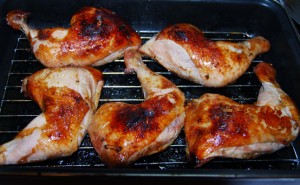
Chicken legs make a nice change from the ubiquitous skinless boneless breasts we’ve
become so used to, and here the chicken stays tender with basting while the skins get nicely crisp. The sauce sounds complicated but is not difficult—but there are a number of steps. You can make this the day before and reheat it with the orange sauce the next day. The result is really worthwhile. Save the bones in the freezer for the next time you make chicken stock.
The orange sauce recipe is the same for either chicken or duck, with small variations, so it is listed separately after the chicken recipe. The sauce uses the orange juice marinade, so you are not wasting the juice!
Preheat the oven to 375 F.
You need
5 or 6 chicken legs with thighs attached, with skins.
For the marinade:
4 oranges, squeezed for 1 cup of juice. Use blood oranges if available.
1 large clove garlic, minced
1 knob of ginger, 1 inch in diameter, grated
freshly ground black pepper
1 tsp salt
For the basting sauce:
1 tbsp olive oil
1 tbsp soy sauce
I tbsp good balsamic vinegar
Steps:
Marinate the chicken
Cut out any obvious fatty bits from the chicken legs and arrange in a dish. Pour over the chicken a marinade made of the orange juice, garlic and ginger and freshly ground pepper. Marinate the chicken legs for 1 hour:
Bake the chicken
Remove the chicken from the marinade and place on a rack in a baking dish.
Make a basting sauce with the olive oil, soy sauce, balsamic vinegar and a little of the marinade.
Bake the chicken legs for an hour, turning once, and basting every 15 minutes. They should be brown, with crispy skin. Because of the marinade and the basting, they will also remain very juicy. They are done when the meat begins to come off the bone.
To serve, put the chicken legs on a platter and pour the orange sauce (below) over them. Serve with quinoa or rice to absorb the sauce, and a green salad.
Orange Sauce for Duck or Chicken
3 tbsp sugar
¼ cup red wine vinegar
3 tbsp orange peel in julienne strips: you will need two oranges
1 cup water
1 cup of chicken broth OR for the duck, the broth from simmering the duck.
1 tbsp flour
Make the sauce:
Strain the marinade from the chicken, or the simmering sauce from the duck and reserve the juices in a bowl.
Julienne the orange peel: Wash well two oranges. With a sharp knife, slice off strips of the orange part of the skin trying not to include any of the white underneath. Make a julienne (thin strips 1 mm wide and 3-4 mm long) of the orange peel. You need 3 tbsp of orange julienne. Put the orange peel in a saucepan with 1 cup of water and boil it for 15 minutes, or until the water almost disappears.
Carmelize the sugar: In a good size saucepan, boil the sugar and the vinegar until the mix is bubbling fast and turning a rich mahogany colour. Remove from heat.
To the carmelized sugar-vinegar mix, add the strained chicken juice/broth and bring to a boil. Put into a small bowl about 2 tbsp of the juice and the flour; mash into a roux, or paste.
Add another 2 tbls of the hot juice/broth and mix well so there are no lumps. Then add the now hot paste back into the broth to thicken the sauce. Once it is well mixed and smooth — use a whisk if necessary — add the orange peel and remove from the heat. Taste for seasoning and add a little salt if you think it needs it.
Once the chicken or duck is on a serving dish, pour the sauce over it, and add a few orange wedges for decoration. Heat well and serve.
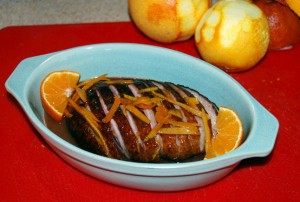
Duck a l’Orange
This is adapted from several sources — Julia Child, the Brome Lake Duck website and freezepac recipe, and Martin Yan’s China for cooking Peking Duck. We can get frozen duck breasts and legs at Cooper’s from the Brome Lake Duck Company in Quebec. The supplier recommends a fast sizzle and sauté approach with the duck breasts remaining pink, like a rare steak. I prefer fowl to be well done, so have come up with the recipe below.
This recipe is similar to the Chicken with Orange Sauce, above. However, there are two additional steps: the duck is not baked, but is first braised in the marinade juices, then later is sautéed, skin down, in ½ inch good oil, to render the fat under the skin and make the skin crispy, the way it is in Chinese duck dishes. The result is duck meat that is tender and well done, very juicy, but with a crispy skin. In China, they would eat this with tiny thin pancakes and fine sticks of cucumber, all with a rich dipping sauce akin to what we call oyster Sauce. I like it with wild rice and a little broccoli or a green salad, and a full-bodied red wine.
You need
2 duck breasts
For the marinade:
4 oranges, squeezed for 1 cup of juice. Blood oranges if available.
1 large clove garlic, minced
1 knob of ginger, 1 inch in diameter, grated
freshly ground black pepper
1 tsp salt
For frying the duck breasts:
1 cup olive oil or grapeseed oil
For the sauce: see above, Orange Sauce for Chicken or Duck.
Steps:
Marinate the duck
Mix the marinade and pour over the duck. Marinate for 1 hour.
Simmer the duck meat
Put the duck and the marinade into a saucepan and bring barely to a boil; simmer very low for 30 minutes. Remove duck to a bowl, refrigerate until ready to proceed. Strain the marinade-now-duck-broth and reserve in a bowl.
Make the orange sauce
Use the recipe above, but use duck broth instead of chicken broth.
Deep fry the duck
Into a large deep saucepan put 1 cup of oil, either olive or grapeseed. Heat until a cube of bread tossed into the pan starts to sizzle, then put in the duck, skin side down. Fry the breasts, moving them about with tongs or a couple of wooden spoons so they don’t stick, and so that all the skin and the fat underneath ends up deep brown and crispy. This will take your full attention for about 15 minutes. When the breasts look brown and crisp and there is no more white fat showing around the edges of the skin, remove to a plate and drain on a paper towel.
To serve
Put each duck piece on a carving board and slice diagonally across the skin and meat, allowing the whole piece to remain attached at the bottom but scored deeply on top. Transfer to a serving dish. Pour over each piece of duck a good half cup of the warmed sauce with the orange julienne. Surround with orange quarters and parsley. Serve the remaining sauce warm in a jug at the table.



